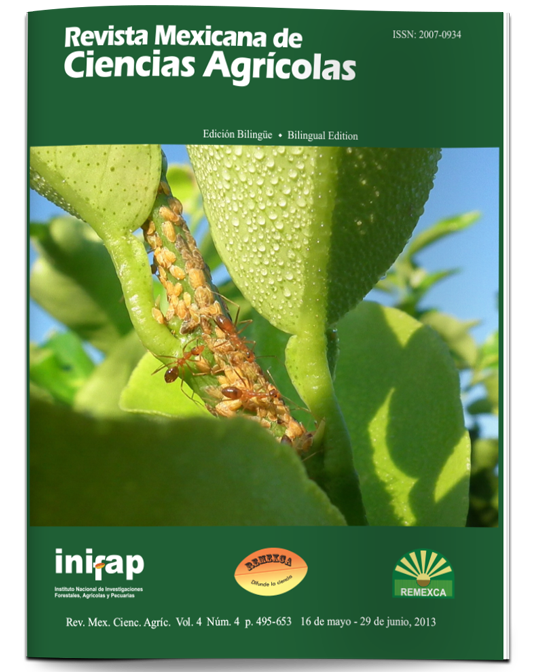Rate of dry matter accumulation of alfalfa in response to climatic variables
DOI:
https://doi.org/10.29312/remexca.v4i4.1183Keywords:
Medicago sativa L., degree-days, evapotranspiration, photoperiod, temperatureAbstract
The information needed for the development of growth models of alfalfa based on the effects of climatic factors on its cultivation has been obtained at higher latitudes and with alfalfa of a higher winter dormancy grade than the alfalfa cultivated in Mexico; it is therefore necessary to estimate the response of alfalfa to different climatic variables under the conditions of the Mexican region (25° N). We used information from six assessments of alfalfa varieties under irrigation during the period 2006-2010. The climatological information was obtained from an automated station Adcon Telemetry 840®. We used the averages for growth, maximum and minimum temperature, daylength, evapotranspiration and accumulation of degree-days (base 5 °C). The response was different in each season: in the winter-spring period all responses were quadratic, with a significant explanation of the variability in the growth rate (GR) of alfalfa (t FS ha-1 day-1): 59, 58, 57, 55 and 27%. In the summer-winter period, with the exception of GDD05, all responses were linear and explained 32, 31, 26, 25 and 10% of the variability in GR with respect to HrL, ETo, Tmin, Tmax and GDD05, respectively . The highest minimum temperatures occurred in the summer and, in combination with the highest photoperiod, affected the GR, reducing the time between cuts, FS production, etc. The information generated can serve as a basis for the development of models to estimate the growth of alfalfa under the conditions and latitude of the "Laguna Region".
Downloads
Downloads
Published
How to Cite
Issue
Section
License
The authors who publish in Revista Mexicana de Ciencias Agrícolas accept the following conditions:
In accordance with copyright laws, Revista Mexicana de Ciencias Agrícolas recognizes and respects the authors’ moral right and ownership of property rights which will be transferred to the journal for dissemination in open access. Invariably, all the authors have to sign a letter of transfer of property rights and of originality of the article to Instituto Nacional de Investigaciones Forestales, Agrícolas y Pecuarias (INIFAP) [National Institute of Forestry, Agricultural and Livestock Research]. The author(s) must pay a fee for the reception of articles before proceeding to editorial review.
All the texts published by Revista Mexicana de Ciencias Agrícolas —with no exception— are distributed under a Creative Commons License Attribution-NonCommercial 4.0 International (CC BY-NC 4.0), which allows third parties to use the publication as long as the work’s authorship and its first publication in this journal are mentioned.
The author(s) can enter into independent and additional contractual agreements for the nonexclusive distribution of the version of the article published in Revista Mexicana de Ciencias Agrícolas (for example include it into an institutional repository or publish it in a book) as long as it is clearly and explicitly indicated that the work was published for the first time in Revista Mexicana de Ciencias Agrícolas.
For all the above, the authors shall send the Letter-transfer of Property Rights for the first publication duly filled in and signed by the author(s). This form must be sent as a PDF file to: revista_atm@yahoo.com.mx; cienciasagricola@inifap.gob.mx; remexca2017@gmail.
This work is licensed under a Creative Commons Attribution-Noncommercial 4.0 International license.



